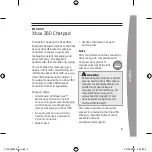
12/06/99
4
ELECTRODE CIRCUIT
Switch #1 on the bottom dip switch is the electrode logic circuit. This circuit
was designed to be used with three electrodes. A high-water, low-water, and
ground electrode.
With switch #1 in the ON position it becomes a low water cut-off circuit (well).
This keeps the pump from running dry in a low yield well. The electrodes are
generally attached to the drop pipe above the pump in a well. When the water in
the well draws down below the high water electrode it does nothing. As it drops
below the low water electrode it turns the pump off. As the water rises again
and passes the low water electrode, the pump stays off. When it reaches the high
water electrode it turns the pump on again. This differential keeps the pump
from rapid cycling.
It is recommended that the ground electrode be placed 2 inches above the pump,
the low water electrode be placed 2 inches above the ground electrode, and the
high water electrode be placed from 2 to 5 feet above the low water electrode;
depending upon the desired draw down.
As a general rule it is recommended that the low water electrode circuit he used
only when absolutely necessary. About 70% of the Low Water Cutoff systems work
flawlessly and 30% seem to have problems. Water with a high mineral content has
a tendency to build up mineral deposits on the electrodes causing false
triggering. Cascading well water may create a current path between electrodes
causing the pump to stay running in low water conditions. Please be advised that
this circuit does not work in all situations.
With switch #1 in the OFF position it becomes a high water cut-off circuit (tank
fill). This keeps a storage tank from over-flowing. The electrodes are generally
taped together and dropped into a tank. small pipe or rod can be installed in
'the tank and the electrodes can then be taped to the pipe or rod.
When the water in the well draws down below the high water electrode the pump
does nothing. As it drops below the low water electrode the pump turns on. As
the water raises again and passes the low water electrode the pump stays on.
When it reaches the high water electrode it turns the pump off again.
It is recommended that the ground electrode be placed 2 inches above bottom of
the tank or the ground wire can be attached to the tank if the tank is metal.
The low water electrode should be placed at the desired turn-on point and the
high water electrode should be placed at the desired turn-off point.
REMOTE SWITCH CIRCUIT
The purpose of the remote switch circuit is to turn the pump on and off from a
distant location without having to switch the main power lines from the solar
modules to the pump. This circuit uses a low voltage, micro-amp circuit to bias
the FET in the controller. This low power switching circuit allows the use of
small gauge wire to run over a thousand feet to control the pump.
Since this is such a sensitive circuit it requires the use of a high quality,
shielded, two-conductor cable. The shield over the wires should then be attached
to the ground terminal in the controller. This in turn is attached to a ground
rod.
Содержание PCB-120
Страница 1: ...PCB 120 DC SUBMERISIBLE PUMP CONTROLLER USER S MANUAL...
Страница 8: ...12 06 99 8...
Страница 9: ...12 06 99 9...




























